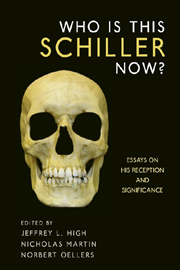Book contents
- Frontmatter
- Contents
- Foreword
- Acknowledgments
- List of Abbreviations
- Introduction: Why Is This Schiller [Still] in the United States?
- Part I Schiller, Drama, and Poetry
- Part II Schiller, Aesthetics, and Philosophy
- Part III Schiller, History, and Politics
- Part IV Schiller Reception — Reception and Schiller
- Part V Schiller Now
- 24 Maria Stuart Adaptations in the Twentieth and Twenty-First Centuries: From “Classical” Parodies to Contemporary Politics
- 25 Whose Schiller Is This? Das Fremde und das Eigene in US Auslandsgermanistik
- 26 Schiller's Political Ideas: Who Cares?
- 27 Where is This Schiller Now?
- Notes on the Contributors
- Index
24 - Maria Stuart Adaptations in the Twentieth and Twenty-First Centuries: From “Classical” Parodies to Contemporary Politics
from Part V - Schiller Now
Published online by Cambridge University Press: 05 February 2013
- Frontmatter
- Contents
- Foreword
- Acknowledgments
- List of Abbreviations
- Introduction: Why Is This Schiller [Still] in the United States?
- Part I Schiller, Drama, and Poetry
- Part II Schiller, Aesthetics, and Philosophy
- Part III Schiller, History, and Politics
- Part IV Schiller Reception — Reception and Schiller
- Part V Schiller Now
- 24 Maria Stuart Adaptations in the Twentieth and Twenty-First Centuries: From “Classical” Parodies to Contemporary Politics
- 25 Whose Schiller Is This? Das Fremde und das Eigene in US Auslandsgermanistik
- 26 Schiller's Political Ideas: Who Cares?
- 27 Where is This Schiller Now?
- Notes on the Contributors
- Index
Summary
This essay focuses on the 2009 staging of Mary Stuart on Broadway in the context of three twentieth-century parodies by Curt Goetz, Bertolt Brecht, and Wolfgang Hildesheimer. Superior parodies can allow readers, critics, artists, translators, and stage directors to take a fresh look at an all-too-familiar work, thereby enabling a separation of the timeworn from the timeless. Since Peter Oswald's new translation/adaptation is the conduit through which both British and American theatergoers have experienced Schiller's Maria Stuart, a discussion of Oswald's textual version is followed by an analysis of the actual performance, paying particular attention to scenes parodied by Goetz, Brecht, and Hildesheimer. Director Lloyd's use of a British and American cast on Broadway, as well as her team's costuming, staging, and sound effects, create a Mary Stuart that seems uncannily at home in a post-9/11 world of religious fanaticism and “enhanced interrogation” of (supposed) enemies of the state.
FOR PURPOSES OF ADDRESSING THE QUESTION “Who is this Schiller [now]?” this study will focus on Phyllida Lloyd's 2009 staging of Mary Stuart on Broadway — but in the context of three twentieth-century parodies of aspects of Schiller's play. Parodies occur when a text has become so (seemingly) well-known that individual lines or scenes begin to take on a life of their own, independent of their original context. In his recent collection of aphorisms, slogans, cartoons, and headlines derived from Schiller quotations, Wolfgang Mieder provides ample proof of how “a too often cited stock phrase develops a natural dynamic toward parody.”
- Type
- Chapter
- Information
- Who Is This Schiller Now?Essays on his Reception and Significance, pp. 403 - 424Publisher: Boydell & BrewerPrint publication year: 2011

